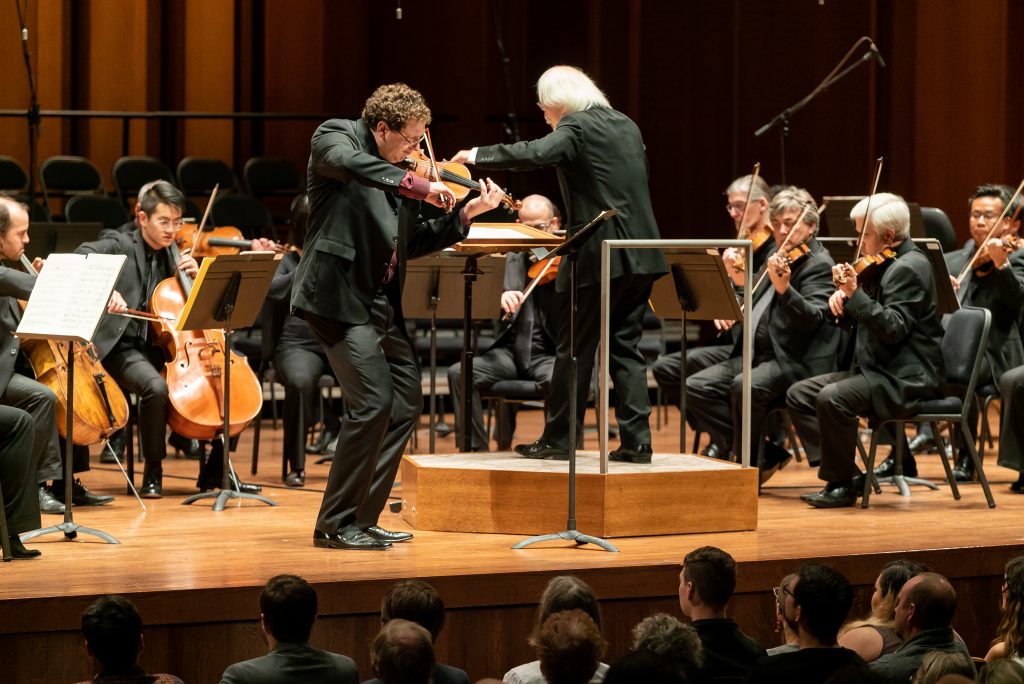By Philippa Kiraly, Special to The Sybaritic Singer
Photo credit: James Holt / Seattle Symphony (used with permission)
It was an unusual line up of works for the Seattle Symphony’s masterworks concerts this weekend: two Requiems each marking the death of an individual, and a concerto composed to mark what felt to the composer like the coming death of a civilized society.
Toru Takemitsu’s seering Requiem for String Orchestra
Led by guest and veteran conductor Masaaki Suzuki, the first half of the performance Thursday included Toru Takemitsu’s 1957 Requiem for String Orchestra, composed in memory of another Japanese conductor, Fumio Hayasaka; and Karl Amadeus Hartmann’s 1939 Concerto funèbre, a musical portrait of his feelings about what was happening around him in Germany and Europe.
Both works are emotionally seering. The ten-minute long Takemitsu, for a small string orchestra, consists largely of short phrases with brief pauses, like taking a breath. The music is often dissonant, mostly slow and quiet, though at one point there’s a brief section with harsh energy. The mood is one of desolation, sad acceptance, full of pain. Suzuki conducted without a baton, as he did the Hartmann, which also used a small string orchestra, but this time with a solo violin.
Noah Geller shines in Concerto funèbre by Karl Amadeus Hartmann
Hartmann was appalled by what the Nazis were doing, and although he remained in Munich for the war’s duration, he refused to have any of his music performed in Germany from 1933 until the end of the war in 1945.

The concerto, in which SSO concertmaster Noah Geller took the solo role, is also a quiet work, largely in an atonal idiom, with the mood of the violin mostly aloof from its surroundings and orchestra. The concerto never feels angry, the overwhelming impression being of sadness, although there are agitated sections in the orchestra, picked up by the soloist. Rather there is a pervasive sense in this section of anxiety, fear, hurry-scurrying. It was a moving performance as Suzuki directed it and Geller played it. Geller’s 1840 violin was built by Andreas Postacchini and with it he played with seeming effortlessness, giving the work depth, sonority, expression and a beautiful smooth sound.
Mozart Requiem – an incongruous choice
After intermission came Mozart’s Requiem, composed at the very end of his life, unfinished at his death and superbly edited and completed by Masato Suzuki (Masaaki Suzuki’s son). This was the first time Suzuki’s version had been performed in Seattle.
However, to pair this work with the Takemitsu and Hartmann felt completely incongruous. Mozart’s may be a Requiem, but he had a very different view of death from that of the later composers and this performance was emphatic, energetic, cheerful, vigorous, even joyful. It just felt wrong, coming after the first half.
Suzuki still used a chamber-sized orchestra, but included the full Seattle Symphony Chorale, where half the members would have been ample. As always under Joseph Crnko, associate conductor for choral activities, it sang with balance, clarity and lovely tone, never forced-sounding.
Three of the four soloists were more problematic. Baritone Morgan Smith sang excellently, particularly when he had to reach into the bottom of the bass range which he did with a full, unstrained sound. Lawrence Wiliford delivered his fine tenor in a manner more appropriate to opera than a Requiem. Soprano Joanne Lunn was the only one of the four who sang long notes straight, without vibrato, but she was sometimes off pitch and at times had a hard edge to her voice. Mezzo-soprano Roxana Constantinescu used her rich voice with a ubiquitous vibrato throughout.
Mozart’s harmonies are rarely dense, clear so that one can hear all the inner workings. When four soloists come together each singing with a vibrato at different speeds, it muddies the harmonies, and that is what happened in this performance. That, combined with the disconcerting juxtaposition of the program choices, made this concert memorable, but not in the best way.

Philippa Kiraly has writing classical music criticism since 1980, for several newspapers in northern Ohio and Seattle, magazines, both local and national, and blogs. She is passionate about the importance of independent criticism for the fine arts, an art in itself which is dying with little interest by many publications and no longer a viable career for most. But writing for tickets is always worthwhile!
Pippa is a keen gardener, a keen grandparent, and can get lost in a good book.
